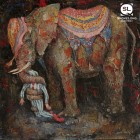What immediately drew me into “Stone, Well, Girl” were the sentences. The rhythm you create in the opening section—where little else happens than a girl kicking a stone up a road—is really incredible in its ability to capture that experience. For most of the story, very little happens, and I admired so much how you were able to propel the story through the language, rhythm, and your careful attention to each sentence. Can you talk a little bit about how you write a sentence, or how you approached the story on a sentence level?
I wish I were one of those people who could slowly unearth one polished gem of a sentence after another—it’s amazing how Lynda Barry paints (!) her first drafts—but I wrote my story in disordered shapeless chunks without much regard to rhythm.
I rewrite obsessively though, and this story in particular demanded an editing process as slow and patient as the piece itself. Sometimes I would remove a comma, sleep on that decision, then wake up the next morning and put it back. I don’t particularly recommend this as a productive process.
I tend to read my sentences in a whisper, especially in the revision process, figuring out where the speaker might pause, or when a sentence, like a rock kicked by the girl, goes too far.
I do a lot of writing on the crowded bus ride to work. Reading my sentences out loud—alas, I also make involuntary hand gestures as I do this—has the added benefit of ensuring the seat next to me is empty. No one wants to sit next to, you know, that guy.
The last line is so powerful, because it names the emotion that has been alluded to throughout the story but has not yet been mentioned. How did you arrive at the last line, or decide to end the story with the word “grief”?
That last sentence came to me, also on the bus, before I had anything. All I had was the image of a girl kicking a stone, and various narrative possibilities: a migrant father toiling in Saudi Arabia, the girl hitching a ride from a stranger, even a gun in her backpack, etc. Then the last sentence appeared and suddenly I had a narrator and an event.
I wondered for a while whether the last sentence felt like I was stating the obvious and not trusting the reader enough. I must have rewritten that section dozens of times though, but not once did I take out that last word. It just felt right.
How did you arrive at the shape of the story? Was it intentional or did it surprise you? Is it just me, or do you see the shape and imagery reflecting the story’s themes?
After a few drafts I was surprised to see that it mirrored what I knew of trauma. After something terrible and unexpected happens to a loved one, you wonder endlessly about what happened, turning the possible circumstances over and over in your mind. You know there will be no real answers, but you try anyway to construct some story that would make sense. In time, a narrative emerges and becomes clearer in your head and all those other possibilities fall away—“I think it must have been a stone”—as you make peace with that version. The sad truth is that the subject of the memory eventually fades and is only remembered in short fragments.
The setting of the story is so rich, but I had to look up the phrase “amihan wind” to learn that “Stone, Well, Girl” takes place in the Philippines. I was very interested in the themes of poverty and development that seem to form a second story that parallels the first, and also (maybe I’m reading too much into this) how those themes connect the feelings of grief and regret to the landscape and setting. Can you talk about how your experiences or knowledge of the Philippines helped you write the story?
At some point the story was going to be more deeply rooted in the Philippines, but I started stripping out a lot of the setting once I figured out the elements. I had a clear idea of the girl’s background, her town, what her house looked like and so on, but I didn’t think those were necessary for the story.
Last year my family and I drove through these small rural towns where the elementary school students seemed to all be let out at the same time—kids laughing and goofing around, in a sea of backpacks and black hair, walking in the road. Five minutes later we’d drive into another town and encounter the same kids, though in different uniforms. They walked in threes or twos but sometimes there’d be one kid walking far behind the others. I remembered those solitary walkers for my story.
This is your first published story, but I learned from Googling that you’ve written a book, Pinoy Capital: The Filipino Nation in Daly City, an ethnography about Filipino immigrants in the U.S. What is it like to publish your first story? How is your fiction related to, different from, or influenced by your work as a researcher?
I have a story published in a Philippine speculative fiction anthology, but this is my first story in a literary journal! And in SmokeLong Quarterly, too! So I’m terribly excited and honored and grateful.
A couple of fiction pieces I’m working on are set during the early part of the American colonial period in the Philippines; my first book, Displaying Filipinos, is on the connection between photography and colonialism in that same era. And I have a dead first draft of a novel that’s partly based on interviews I did with call-center employees in Manila when I was still an academic.
“Stone, Well, Girl” on the other hand has no relation to any research or any real event, other than the fact that I do kick stones from time to time as I walk. Which I try not to do because my dog doesn’t like it.



 The SmokeLong Grand Micro Contest (The Mikey) is now an annual competition celebrating and compensating the best micro fiction and nonfiction online.
The SmokeLong Grand Micro Contest (The Mikey) is now an annual competition celebrating and compensating the best micro fiction and nonfiction online.